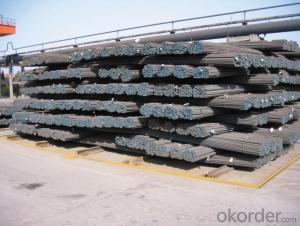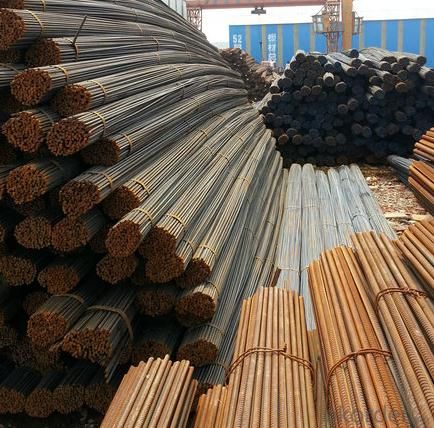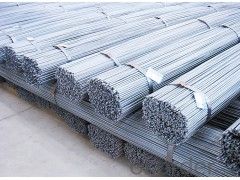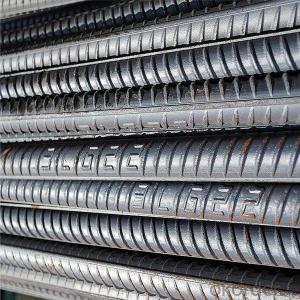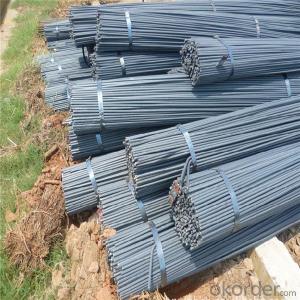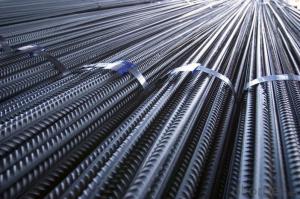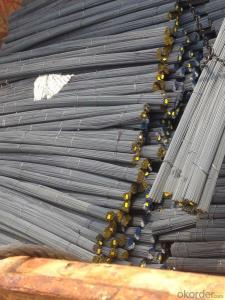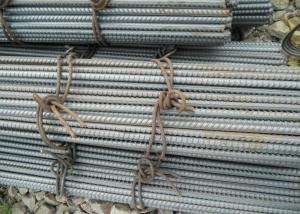Deformed steel bar deformed steel bar for construction
- Loading Port:
- Tianjin
- Payment Terms:
- TT OR LC
- Min Order Qty:
- 10000 m.t.
- Supply Capability:
- 100000 m.t./month
OKorder Service Pledge
OKorder Financial Service
You Might Also Like
Specification
OKorder is offering high quality deformed steel bar deformed steel bar for constructionat great prices with worldwide shipping. Our supplier is a world-class manufacturer of steel, with our products utilized the world over. OKorder annually supplies products to European, North American and Asian markets. We provide quotations within 24 hours of receiving an inquiry and guarantee competitive prices.
Product Applications:
Deformed steel bar deformed steel bar for construction for construction are ideal for structural applications and are widely used in the construction of buildings and bridges, and the manufacturing, petrochemical, and transportation industries.
Product Advantages:
OKorder's deformed steel bar are durable, strong, and resist corrosion.
Main Product Features:
· Premium quality
· Prompt delivery & seaworthy packing (30 days after receiving deposit)
· Corrosion resistance
· Can be recycled and reused
· Mill test certification
· Professional Service
· Competitive pricing
Product Specifications:
Specifications of Deformed Steel Bar:
Standard | GB | HRB335, HRB400, HRB500 | |
UK | G460B, B500A, B500B,B500C | ||
USA | GR40, GR60 | ||
Diameter | 6mm,8mm,10mm,12mm,14mm,16mm,18mm,20mm, 22mm,25mm,28mm,32mm,36mm,40mm,50mm | ||
Length | 6M, 9M,12M or as required | ||
Place of origin | Hebei, China mainland | ||
Application | building,construction,road,bridge etc | ||
Brand name | DRAGON | ||
Theoretical weight and section area of each diameter as below for your information:
Diameter(mm) | Section area (mm²) | Mass(kg/m) |
6 | 28.27 | 0.222 |
8 | 50.27 | 0.395 |
10 | 78.54 | 0.617 |
12 | 113.1 | 0.888 |
14 | 153.9 | 1.21 |
16 | 201.1 | 1.58 |
18 | 254.5 | 2.00 |
20 | 314.2 | 2.47 |
22 | 380.1 | 2.98 |
25 | 490.9 | 3.85 |
28 | 615.8 | 4.83 |
32 | 804.2 | 6.31 |
36 | 1018 | 7.99 |
40 | 1257 | 9.87 |
50 | 1964 | 15.42 |
Usage and Applications of Deformed Steel Bar:
Deformed bar is widely used in buildings, bridges, roads and other engineering construction. Big to highways, railways, bridges, culverts, tunnels, public facilities such as flood control, dam, small to housing construction, beam, column, wall and the foundation of the plate, deformed bar is an integral structure material. With the development of world economy and the vigorous development of infrastructure construction, real estate, the demand for deformed bar will be larger and larger..
Packaging & Delivery of Deformed Steel Bar:
Packaging Detail: products are packed in bundle and then shipped by container or bulk vessel, deformed bar is usually naked strapping delivery, when storing, please pay attention to moisture proof. The performance of rust will produce adverse effect.
Each bundle weight: 2-3MT, or as required
Payment term: TT or L/C
Delivery Detail: within 45 days after received advanced payment or LC.
Label: to be specified by customer, generally, each bundle has 1-2 labels
Trade terms: FOB, CFR, CIF
Deformed Steel Bar in Coil
Produce Line of Deformed Steel Bar
Q1: How soon can we receive the product after purchase?
A1: Within three days of placing an order, we will begin production. The specific shipping date is dependent upon international and government factors, but is typically 7 to 10 workdays.
Q2: What makes stainless steel stainless?
A2: Stainless steel must contain at least 10.5 % chromium. It is this element that reacts with the oxygen in the air to form a complex chrome-oxide surface layer that is invisible but strong enough to prevent further oxygen from "staining" (rusting) the surface. Higher levels of chromium and the addition of other alloying elements such as nickel and molybdenum enhance this surface layer and improve the corrosion resistance of the stainless material.
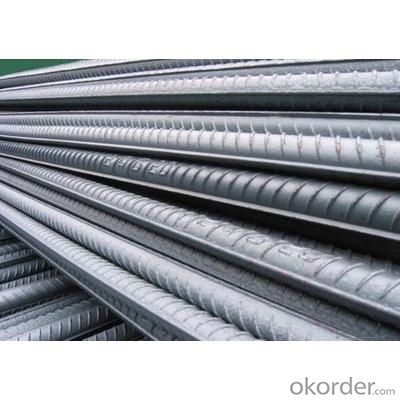
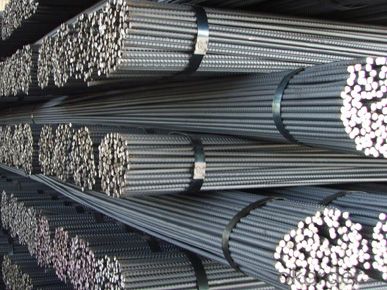
- Q: Can steel rebars be welded together?
- Yes, steel rebars can be welded together using various welding processes such as shielded metal arc welding (SMAW), gas metal arc welding (GMAW), or flux-cored arc welding (FCAW). Welding rebars together is a common practice in construction to create a structural joint that ensures strength and stability in reinforced concrete structures.
- Q: What is the ductility of steel rebars?
- The ductility of steel rebars refers to its ability to deform under tension without fracturing. Steel rebars are known for their high ductility, allowing them to withstand significant bending and stretching without breaking. This property makes them ideal for reinforcing concrete structures, where they can absorb and distribute loads effectively.
- Q: How are steel rebars used in water treatment plants?
- Steel rebars are commonly used in water treatment plants to reinforce concrete structures such as tanks, pipelines, and treatment units. These rebars provide strength and stability to the concrete, ensuring that the structures can withstand the harsh conditions and pressures of water treatment processes.
- Q: What is the typical lead time for ordering steel rebars?
- The lead time for ordering steel rebars can vary depending on various factors, such as the quantity required, the specific grade and size needed, and the availability and location of the supplier. Typically, if the rebars are readily available and in stock, the lead time can range from a few days to a couple of weeks, assuming the supplier has the necessary inventory and transportation logistics are straightforward. However, if the rebars require special manufacturing or are in high demand, the lead time can be longer. In such cases, it may take several weeks or even months to receive the rebars, especially for large or custom orders that involve special fabrication processes or if the supplier is facing production constraints. To obtain a more accurate estimate of the lead time, it is important to communicate with the supplier and provide them with all the necessary project requirements. It is also advisable to plan ahead and place the order well in advance, particularly for projects with strict deadlines, to ensure the timely arrival of the rebars.
- Q: Can steel rebars be used in wind turbine tower construction?
- Yes, steel rebars can be used in wind turbine tower construction. Steel rebars are commonly used in the construction industry as reinforcement in concrete structures. In the case of wind turbine towers, the foundation and tower structure are usually made of reinforced concrete. Steel rebars help to increase the strength and durability of the concrete, making it capable of withstanding the loads and forces exerted by the wind turbine. The rebars provide reinforcement to the concrete and help in distributing the loads evenly throughout the tower structure, ensuring its stability and structural integrity. Therefore, steel rebars play a critical role in wind turbine tower construction and are commonly used in this application.
- Q: What are the guidelines for reinforcing concrete slabs with steel rebars?
- When reinforcing concrete slabs with steel rebars, there are several important factors to consider. Firstly, the required amount of reinforcement must be determined based on the load that the slab will bear. This load can be calculated using structural engineering principles and taking into account factors such as the intended use of the slab, the weight of any equipment or vehicles that will be placed on it, and any applicable building codes or regulations. Once the necessary amount of reinforcement is determined, the next step is to design the layout of the rebars. This involves spacing them at specified intervals to ensure an even distribution of the load across the slab. The spacing will vary depending on the thickness of the slab, with thicker slabs generally requiring more rebars. It is also important to include minimum clearances between the rebars and the edges or bottom of the slab to prevent corrosion and ensure proper concrete cover. The size and type of rebars used is another important consideration. Commonly used types include plain round bars, deformed bars, or welded wire fabric. The diameter of the rebars and the grade of steel should be selected based on the expected load and the requirements of the project specifications or building codes. During the construction process, it is crucial to correctly place and secure the rebars within the formwork to maintain their intended position. This may involve using chairs, spacers, or other devices to ensure proper alignment and prevent displacement. Additionally, care should be taken to avoid damaging the rebars during the pouring and finishing of the concrete. Lastly, it is important to inspect and test the reinforced concrete slab to ensure that the rebars are properly installed and meet the required specifications. This can involve visual inspections, as well as non-destructive testing methods such as ultrasound or ground-penetrating radar to verify the integrity and position of the rebars. In conclusion, adhering to these guidelines for reinforcing concrete slabs with steel rebars will help guarantee the structural integrity and longevity of the slab, while also meeting necessary safety and building code requirements.
- Q: What is the process of painting steel rebars?
- The process of painting steel rebars typically involves several steps. First, the rebars must be cleaned thoroughly to remove any dirt, grease, or rust. This can be done using various methods such as sandblasting, wire brushing, or chemical cleaning. After cleaning, a primer is applied to the rebars to promote adhesion and corrosion resistance. The rebars are then left to dry before the final coating of paint is applied. This final coat can be either a solvent-based or water-based paint, depending on the desired finish and environmental considerations. The rebars are left to dry and cure, and once the paint is fully dried, they are ready to be used in construction projects.
- Q: What is the effect of improper handling on the quality of steel rebars?
- Improper handling of steel rebars can have a significant negative effect on their quality. It can lead to various issues such as bending, warping, or damage to the surface of the rebars. This can compromise their structural integrity and reduce their overall strength and durability. Furthermore, improper handling can also introduce contaminants or impurities to the rebars, which can further degrade their quality and potentially lead to corrosion or other long-term damage. Therefore, proper handling techniques are essential to maintain the quality and performance of steel rebars in construction projects.
- Q: Can steel rebars be used in earthquake-resistant structures?
- Yes, steel rebars can be used in earthquake-resistant structures. Steel rebars provide strength and reinforcement to concrete structures, helping them withstand seismic forces and prevent collapse during an earthquake. The use of properly designed and installed steel rebars enhances the structural integrity and durability of buildings, making them more resilient to seismic activity.
- Q: How do steel rebars affect the overall maintenance requirements of concrete structures?
- Steel rebars play a crucial role in the overall maintenance requirements of concrete structures. These reinforcing bars are used to enhance the strength and durability of concrete by providing tensile strength and preventing cracks. By adding steel rebars to concrete, the structure becomes better equipped to resist the forces that it may encounter during its lifespan. One of the primary ways that steel rebars affect maintenance requirements is by reducing the likelihood of cracks in concrete structures. Concrete on its own is strong in compression but weak in tension. When subjected to tensile forces, such as loads or temperature fluctuations, concrete tends to crack. However, by incorporating steel rebars within the concrete, these cracks are minimized or prevented altogether. This is because the steel rebars absorb the tensile forces, allowing the concrete to remain intact and intact structures require less maintenance. Furthermore, steel rebars also increase the overall strength of concrete structures, making them more resistant to external forces. This added strength reduces the chances of structural failure, thereby decreasing the maintenance requirements in terms of repairs or replacements. Additionally, the use of steel rebars can extend the lifespan of concrete structures, as they provide the necessary reinforcement to withstand the test of time. However, it is essential to note that steel rebars can also be susceptible to corrosion over time, which can impact the maintenance requirements of concrete structures. When steel rebars corrode, they expand, causing cracks and spalling in the concrete. This corrosion can be accelerated by various factors such as exposure to moisture, chloride ions, or carbonation. Therefore, regular inspections and maintenance measures, such as protective coatings or cathodic protection, must be implemented to prevent or manage the corrosion of steel rebars. In conclusion, steel rebars have a significant impact on the overall maintenance requirements of concrete structures. They enhance the strength, durability, and resistance of concrete, reducing the occurrence of cracks and structural failures. However, proper maintenance and protection against corrosion are necessary to ensure the continued effectiveness of steel rebars, ultimately contributing to the longevity and low maintenance needs of concrete structures.
Send your message to us
Deformed steel bar deformed steel bar for construction
- Loading Port:
- Tianjin
- Payment Terms:
- TT OR LC
- Min Order Qty:
- 10000 m.t.
- Supply Capability:
- 100000 m.t./month
OKorder Service Pledge
OKorder Financial Service
Similar products
Hot products
Hot Searches
Related keywords
